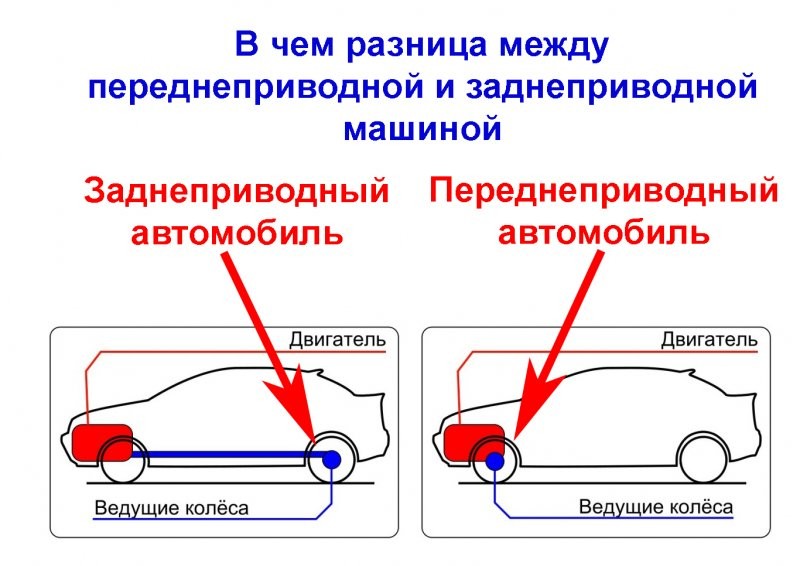
How to know if your car is front wheel drive or rear wheel drive
Content
Every car has some kind of transmission. The transmission is the system that transfers the power from your car's engine to the drive wheels that power your car. The drive consists of:
- half-shafts
- Differential
- Driveshaft
- Transfer case
- Transmission
In a front-wheel drive vehicle, the transmission includes a differential inside the crankcase and does not have a driveshaft or transfer case. In a rear-wheel drive car, all nodes are individual, but there is no transfer case. In a XNUMXWD or XNUMXWD vehicle, each of the components is present, although some parts may or may not be combined together.
It is important to know which transmission design your vehicle uses. You may need to know what transmission you have if:
- You buy spare parts for your car
- You put your car on carts behind your van
- You need to tow your car
- Do you do your own car maintenance?
Here's how you can tell if your car is front-wheel drive, rear-wheel drive, four-wheel drive, or all-wheel drive.
Method 1 of 4: Determine the scope of your vehicle
The type of vehicle you drive can help you determine if your car is front wheel drive or rear wheel drive.
Step 1: Find out what car you have. If you have a family car, compact car, minivan, or luxury car, chances are it's front-wheel drive.
The main exception is cars made before 1990, when rear wheel drive cars were common.
If you drive a truck, full-size SUV, or muscle car, it's most likely a rear-wheel drive design.
Attention: there are exceptions here too, but this is a general recommendation to start your search.
Method 2 of 4: Check Motor Orientation
Your engine layout can help you determine if your vehicle is front wheel drive or rear wheel drive.
Step 1: open the hood. Raise the hood so you can see your engine.
Step 2: Locate the front of the engine. The front of the engine does not necessarily point forward towards the front of the car.
- Belts are installed at the front of the engine.
Step 3: Check the position of the belts. If the belts are pointing towards the front of the vehicle, your vehicle is not front wheel drive.
This is known as a longitudinally mounted engine.
The gearbox is mounted at the rear of the engine and cannot send power to the front wheels in the first place.
If the belts are on the side of the car, your transmission is not rear wheel drive. This is known as a transverse engine mount design.
Attention: Checking engine orientation will help you narrow down your transmission options, but may not fully specify your transmission as you may also have a XNUMXWD or XNUMXWD vehicle.
Method 3 of 4: check the axles
Half shafts are used to transfer power to the drive wheels. If the wheel has a half shaft, then this is the drive wheel.
Step 1: Check under the car: Look under the front of the car towards the wheels.
- You will see the brakes, ball joints and steering knuckle on the back of the wheel.
Step 2: Find a metal rod: Look for a cylindrical metal rod that runs straight to the center of the steering knuckle.
The shaft will be approximately one inch in diameter.
At the end of the shaft, which is attached to the wheel, there will be a corrugated cone-shaped rubber boot.
If the shaft is present, your front wheels are part of your drivetrain.
Step 4: Check the rear differential. Look under the back of your car.
It will be about the size of a small pumpkin and is often referred to as a gourd.
It will be installed directly between the rear wheels in the center of the vehicle.
Look for a long, sturdy gourd tube or axle shaft that looks like a front axle shaft.
If there is a rear differential, your car is built into the rear wheel drive design.
If your vehicle has both front and rear drive axles, you have an all wheel drive or all wheel drive design. If the engine is transverse and you have front and rear drive axles, you have a four-wheel drive vehicle. If the engine is located longitudinally and you have front and rear axles, you have a four-wheel drive car.
Method 4 of 4: Search VIN
The vehicle identification number can help you identify your vehicle's transmission type. You will need internet access, so you won't be able to use this method if you find yourself in a situation on the road.
Step 1: Find a VIN Lookup Resource. You can use popular vehicle history reporting sites such as Carfax and CarProof which require payment.
- You can also find a free VIN decoder online, which may not provide complete information.
Step 2: Enter the full VIN number into the search. Submit to view results.
- Provision of payment if necessary.
Step 3: View the results of the transmission tuning.. Look for FWD for front-wheel drive, RWD for rear-wheel drive, AWD for all-wheel drive, and 4WD or 4x4 for all-wheel drive.
If you've tried all of these methods and are still not sure what type of drive your car has, have a professional mechanic take a look at your car. Knowing what transmission you have is important if you ever need to tow your car, buy parts for it, or tow it behind a motorhome.